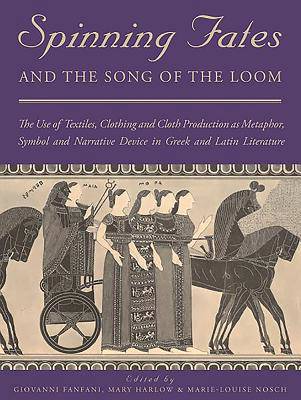
- Retrait gratuit dans votre magasin Club
- 7.000.000 titres dans notre catalogue
- Payer en toute sécurité
- Toujours un magasin près de chez vous
- Retrait gratuit dans votre magasin Club
- 7.000.0000 titres dans notre catalogue
- Payer en toute sécurité
- Toujours un magasin près de chez vous
Spinning Fates and the Song of the Loom
The Use of Textiles, Clothing and Cloth Production as Metaphor, Symbol and Narrative Device in Greek and Latin Literature
66,95 €
+ 133 points
Description
Textile imagery is pervasive in classical literature. An awareness of the craft and technology of weaving and spinning, of the production and consumption of clothing items, and of the social and religious significance of garments is key to the appreciation of how textile and cloth metaphors work as literary devices, their suitability to conceptualize human activities and represent cosmic realities, and their potential to evoke symbolic associations and generic expectations.
Spanning mainly Greek and Latin poetic genres, yet encompassing comparative evidence from other Indo-European languages and literature, these 18 chapters draw a various yet consistent picture of the literary exploitation of the imagery, concepts and symbolism of ancient textiles and clothing. Topics include refreshing readings of tragic instances of deadly peploi and fatal fabrics situate them within a Near Eastern tradition of curse as garment, explore female agency in the narrative of their production, and argue for broader symbolic implications of textile-making within the sphere of natural wealth The concepts and technological principles of ancient weaving emerge as cognitive patterns that, by means of analogy rather than metaphor, are reflected in early Greek mathematic and logical thinking, and in archaic poetics. The significance of weaving technology in early philosophical conceptions of cosmic order is revived by Lucretius' account of atomic compound structure, where he makes extensive use of textile imagery, whilst clothing imagery is at the center of the sustained intertextual strategy built by Statius in his epic poem, where recurrent cloaks activate a multilayered poetic memory.
Spanning mainly Greek and Latin poetic genres, yet encompassing comparative evidence from other Indo-European languages and literature, these 18 chapters draw a various yet consistent picture of the literary exploitation of the imagery, concepts and symbolism of ancient textiles and clothing. Topics include refreshing readings of tragic instances of deadly peploi and fatal fabrics situate them within a Near Eastern tradition of curse as garment, explore female agency in the narrative of their production, and argue for broader symbolic implications of textile-making within the sphere of natural wealth The concepts and technological principles of ancient weaving emerge as cognitive patterns that, by means of analogy rather than metaphor, are reflected in early Greek mathematic and logical thinking, and in archaic poetics. The significance of weaving technology in early philosophical conceptions of cosmic order is revived by Lucretius' account of atomic compound structure, where he makes extensive use of textile imagery, whilst clothing imagery is at the center of the sustained intertextual strategy built by Statius in his epic poem, where recurrent cloaks activate a multilayered poetic memory.
Spécifications
Parties prenantes
- Editeur:
Contenu
- Nombre de pages :
- 300
- Langue:
- Anglais
- Collection :
- Tome:
- n° 24
Caractéristiques
- EAN:
- 9781785701603
- Date de parution :
- 01-09-16
- Format:
- Livre relié
- Format numérique:
- Genaaid
- Dimensions :
- 185 mm x 246 mm
- Poids :
- 1179 g

Les avis
Nous publions uniquement les avis qui respectent les conditions requises. Consultez nos conditions pour les avis.





